
In today’s digital age, the terms IPTV (Internet Protocol Television) and OTT (Over-the-Top) streaming services are often used interchangeably, yet they represent distinct technologies with unique characteristics. This blog post aims to clarify the differences between IPTV and OTT, shedding light on their respective functionalities, delivery methods, and implications for consumers and providers.
1. IPTV (Internet Protocol Television)
IPTV refers to television services delivered over IP networks, such as the internet, instead of traditional methods like satellite or cable. It utilizes dedicated IPTV networks managed by service providers, ensuring controlled delivery of live TV channels, on-demand content, and interactive features. Key aspects of IPTV include:
Managed Network: IPTV operates over managed networks controlled by service providers, ensuring quality of service (QoS) through prioritization of traffic and dedicated bandwidth allocation.
Quality and Reliability: IPTV offers high-quality video and audio streaming with minimal buffering or interruptions, particularly suited for live broadcasts and interactive applications.
Interactive Features: IPTV platforms often integrate interactive features like video-on-demand (VOD), time-shifted TV (rewinding or pausing live TV), and personalized content recommendations.
Click here for IPTV services:
2. OTT (Over-the-Top) Streaming Services
OTT streaming refers to content delivered directly over the internet to viewers’ devices, bypassing traditional distribution channels like cable or satellite. OTT services are typically accessed via apps or websites and do not require a dedicated IPTV network. Key aspects of OTT include:
Internet Delivery: OTT services use the public internet for content delivery, leveraging existing broadband connections without requiring specialized infrastructure.
Device Compatibility: OTT content is accessible on a wide range of devices, including smartphones, tablets, smart TVs, and gaming consoles, offering flexibility in viewing options.
Content Variety: OTT platforms offer diverse content libraries, including movies, TV shows, original programming, and live streams, catering to global audiences with varied interests.

Key Differences Between IPTV and OTT
1. Network Infrastructure
IPTV: Operates over managed networks with dedicated bandwidth and QoS mechanisms controlled by service providers. This ensures consistent performance and reliability but may limit scalability beyond provider-defined regions.
OTT: Relies on the public internet for content delivery, allowing for broader reach and scalability across global audiences. OTT services can accommodate varying network conditions but may experience occasional buffering or quality fluctuations.
2. Content Delivery and Access
IPTV: Content delivery in IPTV is typically linear or scheduled, akin to traditional broadcast TV, with limited interactivity and real-time updates. Viewers access content through set-top boxes or specialized IPTV apps provided by service operators.
OTT: Offers on-demand access to content libraries, enabling viewers to choose what and when to watch. OTT platforms use apps or web interfaces for content consumption, supporting interactive features like user profiles, recommendations, and multi-device synchronization.
3. Business Models and Monetization
IPTV: Often bundled with traditional telecom services (e.g., internet and phone), IPTV generates revenue through subscription fees and value-added services like premium channels or pay-per-view events.
OTT: Embraces flexible monetization models, including subscription-based (SVOD), advertising-supported (AVOD), and transactional (TVOD) services. OTT providers monetize content through subscriptions, ad revenues, and partnerships with content creators.
Implications for Consumers and Providers
1. Consumer Choice and Flexibility
Consumers:IPTV offers reliable service with a focus on live TV and interactive features, appealing to viewers seeking a traditional TV experience with enhanced functionalities. OTT provides flexibility with on-demand access and diverse content options, catering to personalized viewing preferences across multiple devices.
2.Market Dynamics and Competition
Providers:IPTV providers differentiate through service quality, network reliability, and bundled offerings, targeting local markets with tailored content packages and value-added services. OTT providers compete on global scales, focusing on content diversity, user experience, and innovative distribution strategies to attract and retain subscribers.

Conclusion
In conclusion, while IPTV and OTT share the common goal of delivering digital content to audiences, their approaches, infrastructures, and functionalities differ significantly. IPTV excels in managed network environments, ensuring quality service for live broadcasts and interactive TV experiences. In contrast, OTT leverages internet-based delivery to offer diverse content libraries and flexible viewing options across global audiences.
For the best IPTV services click on the link given below:
As consumer preferences evolve towards personalized, on-demand content consumption, both IPTV and OTT will continue to play pivotal roles in shaping the future of digital entertainment. Understanding the distinctions between these technologies helps consumers make informed choices and enables providers to innovate and adapt to dynamic market demands effectively.










Leave a Reply